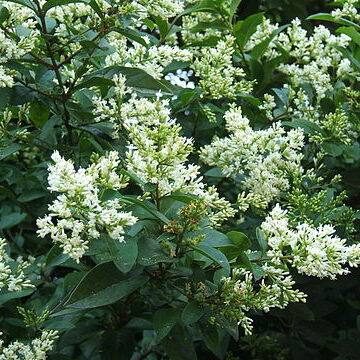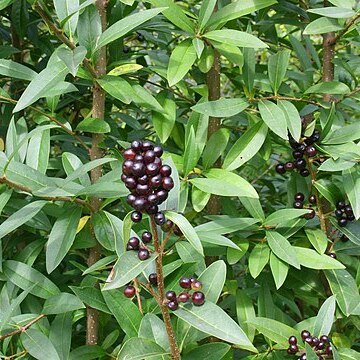Shrubs or small trees, deciduous or evergreen. Leaves opposite, simple, short petiolate; leaf blade entire. Inflorescences terminal panicles of cymes, rarely lateral. Flowers bisexual, sessile or pedicellate. Calyx campanulate, truncate or 4-toothed, persistent. Corolla white, rotate, funnelform, or salverform, 4-lobed; lobes ca. as long as or shorter than corolla tube, valvate in bud. Stamens 2, inserted at mouth of corolla tube, included or exserted; anthers yellow or sometimes purple, oblong. Ovules 2 in each locule, pendulous. Style shorter than stamens; stigma 2-cleft. Fruit a berrylike drupe with membranous or papery endocarp, rarely drupaceous or loculicidal. Seeds 1-4; endosperm fleshy; radicle short, upward.
Fls perfect; cal small, obconic or campanulate, truncate or obscurely 4-lobed; cor salverform, the 4 lobes spreading or recurved; stamens 2; anthers large; ovules 2 per locule; stigma capitate; fr a small black drupe; shrubs with simple, short-petioled, entire lvs and small panicles of white fls terminating the main axis and short lateral branches. 40, Old World.A number of spp. are cult. and occasionally escape, but only L. vulgare is commonly established. Some of the other spp. are keyed, but only L. vulgare is described.
Erect, deciduous or evergreen shrubs, sometimes forming small or medium-sized trees. Shoots ± terete, prominently lenticellate. Winter buds inconspicuous. Lvs opposite, simple, entire. Infl. a terminal panicle of small, ☿, usually scented fls. Calyx 4-lobed, campanulate, small. Corolla 4-lobed, salverform; tube sometimes much > the valvate lobes. Stamens 2, included or exserted, epipetalous; filaments short. Style < stamens; stigma 2-lobed. Fr. a berry-like drupe, black or very dark, 1-4-seeded.


